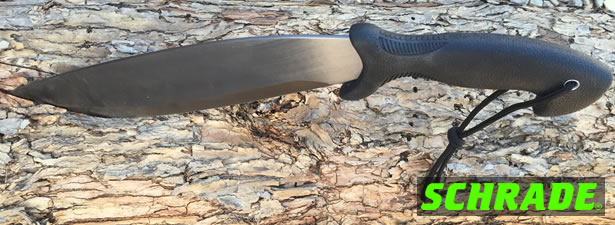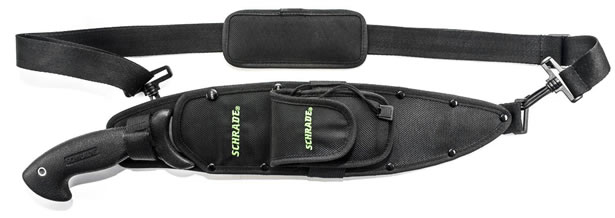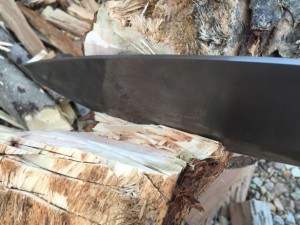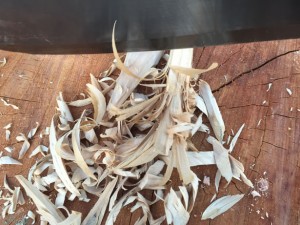Schrade SCHBOLO Machete Reviewed

Marketing from Schrade
The Schrade Survival Bolo Machete Knife – SCHBOLO – has Massive, 14″ Blade, Full Tang with Rubberized Safe-T-Grip, Ballistic Nylon Sheath, Field Sharpening Stone and Ferro Rod.
The knife has a full tang, which runs the entire length of the bolo, through the handle, providing a strong, durable build that you can rely on in any situation. The ergonomic, rubberized, Safe-T-Grip handle helps keeps the blade in your hand, in all weather conditions. For extra security, there’s a lanyard hole through the end of the tang.
Housed in a rugged, reinforced, ballistic nylon sheath, the Survival Bolo is held firmly in place with an adjustable strap and two sheath snaps. On the front, there’s a small, detachable sheath that houses a diamond, field sharpening stone and extra large, fire-igniting, ferro rod. The back side of the sheath has a removable and adjustable sling strap and 2 loops for multiple carry options.
Manufacturer: Schrade, www.schrade.com
Model: SCHBOLO
Overall Length: 20.3 inch (51.5 cm)
Blade Steel: Titanium Nitride Coated 3Cr13 Stainless Steel Blade
Blade Length: 14.0 inch (35.5 cm)
Blade Thickness: 4 mm
Handle Material: Safe-T-Grip Handle
Handle Length: 7.3 inch (18.5 cm)
Weight: 1.69 lbs (27.04 oz)
Accessories: Nylon Shoulder/Belt Sheath w/ Storage Pouch, Field Sharpener, Fire Striker
Warranty: Limited Lifetime Warranty against any manufacturing defects
MSRP: $68.00
UPC: 044356216814
The Review
What primary blade would you pack in your bag for performing heavier tasks like trailblazing, building a shelter, or basic bushcrafting? A large survival knife, a small hand axe, or a machete? Since no one tool can be the best at everything, what feature or function is most important to you? Today, I’ll be checking out Schrade’s SCHBOLO Machete. Lets see how well it stands up to the task at hand…

Initial Thoughts
After reviewing Schrade’s SCHKM1 Kukri Machete last year, I was really excited to get my hands on their SCHBOLO machete. I was rather impressed with their kukri machete so when I heard about their SCHBOLO Machete, I knew had to get one and check it out for myself.
When I opened up the box and pulled the SCHBOLO, I could immediately see the similarity between the sheath provided with Schrade’s Kukri Machete and the one provided with the SCHBOLO. It is a large ballistic nylon shoulder/belt sheath and carrying strap with a field sharpener and ferro rod neatly packed in a small removable storage pouch attached to the front.
SCHBOLO’s titanium nitride coated 3Cr13 stainless steel blade is big and shiny. So much so that it could easily second as a signalling mirror. To me, the SCHBOLO loosely resembles that of a giant survival knife rather than a traditional machete. As such, the SCHBOLO is very well-balanced machete, comfortable to grip and easy to wield.
The ergonomic Safe-T-Grip textured handle is a hard rubberized plastic similar to Schrade’s TPE handles providing a durable, secure grip even in wet conditions. The handle also includes a lanyard hole and lanyard.
 I am definitely looking forward to seeing what this thing can do in the field.
I am definitely looking forward to seeing what this thing can do in the field.
Features
Now lets focus on the SCHBOLO’s features in more detail…
The Blade
Schrade’s SCHBOLO is a fine-edged machete constructed from a single 4mm-thick slab of titanium nitride coated 3Cr13 stainless steel. The SCHBOLO has an overall length of 20.3 inches with a blade length of 14 inches, and a total weight of 27.04 ounces. From tip to tang, this stout blade design provides the foundation for its exceptional strength and durability, just what you would expect from any good survival blade.
3Cr13 stainless steel is similar in quality, strength, hardness, corrosion resistance and edge retention to 420B stainless steels. Stainless steel is a popular class of material for knife blades because it has properties that are resistant to rust and corrosion, while remaining easy to maintain. This makes it an excellent choice for a survival blade. This alloy is typically easier to sharpen than many other stainless alloys like 440C, and it can hold an edge rather well.
While the 3Cr13 stainless steel and full-tang blade design are certainly durable enough to withstand quite a lot of punishment, it is only rust resistant, and not rust proof. Even with the protective titanium nitride coating, it is still susceptible to rust without proper care and maintenance. If the blade becomes wet, simply dry it thoroughly and lightly coat it with an oil like Break-Free CLP before storage. If you do, it will likely last you a lifetime.
The blade pattern was inspired by the barong, a thick leaf-shaped single-edged bolo machete used by the Islamic tribes of the Southern Philippines. The barong’s unique leaf-shaped blade make it easily distinguishable from other Filipino bolo machete blade patterns. It is still widely used in Southeast Asia for clearing vegetation, trailblazing, and bushcraft tasks.
The SCHBOLO machete has an attractive drop-point profile and deep hollow-grind with a compound bevel which happens to be a very common grind on factory knives today. A drop-point profile can best be described as a blade with a convex curve that extends from the spine to the tip of a varying length providing a strong, robust blade that is easy to direct when chopping, slicing and prying, but is typically less suitable for piercing. However, in the case of the SCHBOLO, the blade’s convex edge coupled with its large drop-point produce an aggressive point ideal for piercing.
The weight and shape of this blade provide ample leverage, perfect for heavier bushwhacking tasks like chopping and log splitting as well as lighter bushcraft tasks like carving and shaving sticks. The SCHBOLO’s spine also works well when striking a ferro rod against the spine, with or without the protective coating though the ferro rod does come with an attached striker.
The Handle
The SCHBOLO features a durable 7.3 inch Safe-T-Grip handle comfortably shaped with a large palm-swell, front quillon or finger guard and a rear quillon to provide ample leverage, balance and grip as you wield the machete, even in the wettest of conditions.
The overmolded Safe-T-Grip textured handle is a hard rubberized plastic similar to Schrade’s TPE handles, but not slabbed. Safe-T-Grip is best described as a highly durable colored high friction surface treatment consisting of a thermosetting epoxy dressed with pigmented or natural high-friction aggregates.
The handle also includes a lanyard hole and lanyard, but does not have an exposed pommel area.
The Sheath
Schrade provided a large ballistic nylon shoulder/belt sheath with the SCHBOLO. The sheath includes an over-the-shoulder carrying strap in addition to two leg straps and a belt loop. Although the sheath is single-stitched, it is riveted for durability.
Packed in the removable storage pouch is a field sharpener and Ferro rod. I haven’t had the opportunity to try out the field sharpener yet, but the Ferro rod is an excellent size and quality. It will provide an ample amount of heat and spark with each strike to get a fire going quickly.

Functional Testing
Now lets see how the SCHBOLO performs in the field… In order to provide a some sort of apples-to-apples comparison between blades, I will be performing five durability tests; Batoning, Chopping, Feather Stick, Tip Strength and Edge Retention. In a survival situation, all resources are fair game. However, since I am not in a life-or-death situation, I’ll stick to some seasoned wood that I have lying around for these tests.
Batoning
Per Wikipedia: Batoning is the technique of cutting or splitting wood by using a baton-sized stick or mallet to repeatedly strike the spine of a sturdy knife, chisel or blade in order to drive it through wood. The batoning method can be used to make kindling or desired forms such as boards, slats or notches. The practice is most useful for obtaining dry wood from the inside of logs for the purpose of fire making.
To properly rate the SCHBOLO’s ability to be used with a baton, I split this test into two parts. First to split smaller diameter logs into kindling, and second to split a larger bucked log. But first I needed a good baton about 3″ in diameter by 18″ in length which wasn’t too difficult to find.
The goal of part one is simply to section off a few 6″ logs into small kindling. To begin, I set the first log up on its end and placed the blade on top. Then I began to strike each end of the blade’s spine evenly with the baton as it steadily made its way through the length of the log without much effort.
I repeatedly split each log into numerous smaller pieces until I had a pile of similarly-sized tinder. Some green and some that had been left drying for a few of seasons. The SCHBOLO and baton put on a stellar performance throughout part one, even with all of the twists and knots that I ran into.
For part two, the larger material that I chose to split was a bucked log about 12″ in diameter and a little less than 18″ long. Splitting off larger material with a small axe or blade is typically performed by sectioning off 1-2″-thick slices from around the outer-edge of the log, parallel to the outermost rings. Then split them down further as necessary.
After setting the log up, I began to work my way around by striking each end of the blade’s spine with the baton as before, slowly moving inward toward the center until the center core of the log was small enough to quarter. As long as you don’t attempt to bite off too much at a time, the SCHBOLO will glide through the length of the log.
There is no question that the SCHBOLO performed quite well at batoning. Likely better than any knife or machete that I’ve batoned with in the past. The SCHBOLO’s thick 4mm blade and long-convex spine provide ample rigidity and surface area to strike against without any risk of bending the blade or damaging the spine. However, the overmolded handle does not take abuse to the spine like a slabbed handle that exposes the spine would. Therefore, to avoid damaging the Safe-T-Grip material, it is best to avoid striking the handle area altogether.
 Chopping
Chopping
To test the SCHBOLO’s ability to function as a chopper, I figured that it would best to buck a log into a few manageable pieces after delimbing it. Much like you would need to do if you were building a shelter or creating a stockpile of firewood. I think this is as close as I can get to a real-world situation.
At nearly 1.7 pounds, the thick-broad blade and long-convex hollow-ground edge of the SCHBOLO generates a tremendous amount of cutting force with each strike. As a result, the SCHBOLO can easily cut through all of the smaller limbs, often with only a single swing. This made delimbing the logs quick and easy. Before I knew it, I was ready to start working the heavier material.
When bucking a log larger that a few inches in diameter with the SCHBOLO, you simply strike the log at a 45° angle from two perpendicular directions along the cut-line, effectively making a “V” in the material used to be, otherwise known as the kerf. The kerf should equal the diameter of the limb or trunk, and when cutting from both sides, the kerf would essentially be half diameter.
The SCHBOLO is a real a log-eater. It bites deeply with each swing causing the chips to go flying. While the SCHBOLO definitely wouldn’t be my first choice to buck any material larger than 8 to 10 inches, It could certainly be used to do so making it a fine choice for outdoor survival.
The ergonomic Safe-T-Grip easily absorbs the majority of the shock making it comfortable to wield with or without gloves without any risk of blisters.
Feather Stick
Per Wikipedia: A feather stick (sometimes referred to as a fuzz stick) is a length of wood which is shaved to produce a head of thin curls protruding from the wood. It is used for damp wood to start a fire (or campfire) when dry tinder is hard to find.
The next test is to create a feathered stick for some firemaking. When feathering a stick and most other fine bushcraft tasks with a large blade like the SCHBOLO, I find it much easier to set the end of the blade into a stump at a 60° angle, then manipulate the material instead. In most cases, the result is a much higher-level of fine control.
 With a stick of douglas fir I proceeded to shave thin curls around the stick. The SCHBOLO is certainly sharp enough right out of the box to perform well at this task. Before I knew it, I had a pile of thinly-cut curls and a short cone of curls on the end of my stick. All in all, the SCHBOLO performed exceptionally well at this task.
With a stick of douglas fir I proceeded to shave thin curls around the stick. The SCHBOLO is certainly sharp enough right out of the box to perform well at this task. Before I knew it, I had a pile of thinly-cut curls and a short cone of curls on the end of my stick. All in all, the SCHBOLO performed exceptionally well at this task.
Tip Strength
To test the SCHBOLO’s ability to stab and pierce without damaging the tip, I drove the tip of the blade into the end of a 12″ diameter stump as hard as I could. Then I loosened the blade using a side-to-side motion until it was loose enough to pull out. I repeated this action a few more times just for good measure.
Next, I used the SCHBOLO to bore a cone-shaped hole into the side of a small log approximately 1″ in diameter and about 1″ deep simply by twisting the blade until the hole was deep enough.
Finally, I decided to throw the SCHBOLO at a tree stump from about 10′ away to see if I could get it to stick. And it did. The SCHBOLO is certainly balanced enough to throw. Although the handle material is really not durable enough to withstand this kind of abuse. I repeated this part of the tip test a couple more times before I decided to move on with the testing.
Edge Retention
Even after all of the other functional tests, the SCHBOLO easily sliced through a single sheet of printer paper without issue. The SCHBOLO handily survived all tests, leaving no sign of cracks, chips or other imperfections of any kind on the blade with the exception of some slight wear on the blade’s protective coating. The SCHBOLO held its edge and remained very sharp through the entire process, even with all of the punishment that I threw at it.
Final Thoughts
Attractive design, rugged performance and built to last, Schrade’s SCHBOLO machete is ideal as a survival blade. The broad blade, long convex edge, and deep hollow-grind of the SCHBOLO are shaped perfectly for splitting, chopping, and the edge is certainly sharp enough to perform most fine bushcraft tasks. However, its large stature can make smaller detail work much more difficult. It is a little big for the real small stuff and a little small for the real big stuff, but perfect for everything in-between.
The only negative comments that I have for this blade are directly related to its handle. It is a little soft so it is not as tough as a TPE or Micarta so the tradeoff comfort for durability. Additionally, the shape of the finger guard could be tweaked a little… Rather than sweeping the lower fingerguard so far forward, if it was shorter the blade’s edge could extend further back.
The SCHBOLO is an affordable option that can be found most anywhere on the Internet for around $40, so whether you are bugging-out or trekking through the great outdoors, the SCHBOLO is an impressive blade that is more than capable of successfully performing a multitude survival tasks. As such, it worthy of inclusion in any survival pack. Schrade… Two thumbs way up for this one!
You can find this and other Schrade products here: http://amzn.to/2c0kjZF
![]()
About Taylor Brands and Schrade Cutlery
 Founded by Stewart Taylor in 1975, Taylor Brands has been manufacturing, designing, and distributing high-quality stainless steel cutting tools and accessories since our inception. Taylor Brands owns and produces Schrade, Old Timer, Uncle Henry, and Imperial branded products, and are also licensed to produce multiple product lines under the world famous Smith & Wesson brand. In total Taylor Brands manufactures several hundred different products including fixed and folding knives, collapsible batons, tactical pens, handcuffs, tactical and survival accessories, and flashlights.
Founded by Stewart Taylor in 1975, Taylor Brands has been manufacturing, designing, and distributing high-quality stainless steel cutting tools and accessories since our inception. Taylor Brands owns and produces Schrade, Old Timer, Uncle Henry, and Imperial branded products, and are also licensed to produce multiple product lines under the world famous Smith & Wesson brand. In total Taylor Brands manufactures several hundred different products including fixed and folding knives, collapsible batons, tactical pens, handcuffs, tactical and survival accessories, and flashlights.
--